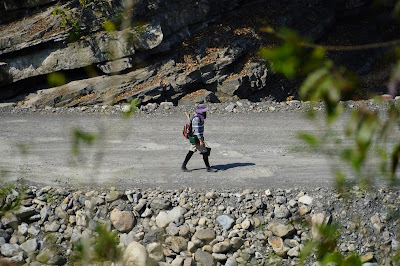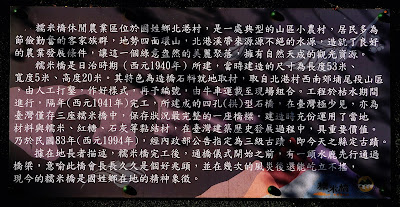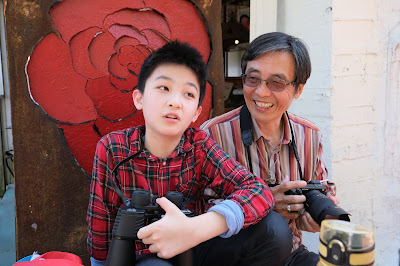for the 2nd Sunday in Lent
"Moving Uphill and Downhill, and Then?"
My Reflections on
the Trilogy, the Structure of Mark, and Something about Lent
I.
Introduction:
The Gospel reading we’ve just heard is
Mark 8:31-38; that is the final part of the eighth chapter. Do you know which
verse has impressed me so much that I’ll never forget it? – Or let’s put it another
way: In the Gospel reading for today, which verse or verses are the most impressive
to you?
Well, my
answer to this question is Verse 34: “Then Jesus
called the crowd and his disciples to him. ‘If any of you want to come with
me,’ he told them, ‘you must forget yourself, carry your cross, and
follow me.’” (GNT)
Listen to it
again, in another version: “[Jesus said,] ‘If
any want to become my followers, let them deny themselves and take up their
cross and follow me.’” (NRSV)
What a
striking teaching it is! Even now I can recall what Prof. David Dai said: “It is the trilogy
of being a follower of Jesus (gēnsuí Zhǔ-Yēsū de sānbùqǔ, or sānbùzòu):
(1) Deny yourself, (2) take up your cross, and (3) follow Him.” – It’s been a long, long time since my graduation
from Shīdà (NTNU), but I still remember what my Bible teacher at
university said about this sānbùqǔ (“trilogy”).
By the way, I
remember a joke told by him, who taught me The Bible as Literature about
36 years ago (in 1984-1985). He said he had asked his students in another class
to “preview” the Gospel of Mark, and when he went to that class the next week, he
asked them, “Have
you ever finished reading all the 17 chapters of Mark? If you have, raise your
hands,” about half of the class
raised their hands.
Then he asked
the rest of the class, “How about you? Didn’t you read? At least you should have
read the first and the final few chapters. Now, if you finished reading Chapters
1 & 2 and 16-17, please also raise your hands.” A few more students raised their hands. – This is
a joke! No doubt.
Why? … Why
was that a joke? – How many chapters does Mark’s Gospel consist of? – It
contains sixteen chapters only.
Now turn to
see this. Look! What does it look like? … [Show a triangle made of card
paper, shaped like a mountain and representing the structure of Mark’s Gospel.]
II.
The Structure of Mark’s
Gospel*:
[* In this section the ideas and the wording are mostly taken from Rev.
Judith Carrick’s sermon with the same title, 2003; thanks for the inspiration!]
The structure
of Mark’s Gospel is like a mountain. As we go up one side, we hear about the
ministry of Jesus; the miracles, the healings, the feeding of
thousands, the calling of the disciples. The top of the mountain is Peter’s declaration, “You are the Christ,”
(Mark 8:29) the first time it is stated exactly who Jesus is. And then, starting
today, we come down the other side of the mountain toward the cross.
Before Peter’s
declaration, “You are the Christ,” there must have been a good deal of speculation
about who Jesus was, not just among the disciples, but among ordinary folk
as well. In the first half of Mark, we see the core
issue that many people explored: Who was
this man, Jesus?
Of course,
finding out exactly who Jesus was brought the disciples more than they
had expected. When Jesus told them that he was to be rejected, abused, and
even killed, Peter rebuked him. In his human nature, Peter could not
imagine such a thing happening to a messiah. It’s
obvious that suffering was not part of Peter’s dream for Jesus, nor probably
for himself or any of the other disciples.
So Jesus had
to continue his teaching to his disciples and others, revealing to them the
true nature of his mission on earth and, by extension, their mission
as well. Just as Jesus in his healing ministry gradually opened the eyes of the
blind man at Bethsaida, so he gradually revealed to his disciples and others the nature and implications of his “messiahship.”
“Jesus would
lead; his disciples would follow.” This was not to be a partnership of equals.
They must be prepared to deny themselves, to abandon any thoughts of
self-centeredness. They must be prepared to take up their cross, to
perhaps face martyrdom.
And all for
the sake of spreading the good news of the kingdom of God, to attain true life in the age to come, they must trust
in God and obey God’s will, being willing to accept loss and injury in the
cause of Christ and his Gospel. Simply put, they must follow Christ’s
example, to become more like him.
Today, like Jesus’
first disciples, we also have to learn to transform ourselves by not being
self-centered, by taking up our own cross, taking on our
responsibilities; and by following the Lord, as a real Christian.
This
three-step process seems no easy job. Can we understand the significance of it and
put it into practice? When we continue to read the 2nd half of the
Gospel of Mark, I believe we’ll see a lot more about the other side of the mountain; we’ll have a better
understanding of the Truth that the author of Mark would eagerly show in the
whole structure of his Gospel.
III.
My Reflections on “Moving Uphill
and Downhill”:
[Show the visual aid.] Look at this mountain again; it represents the
structure of Mark’s Gospel. Just now I mentioned that the top of the mountain
is Peter’s declaration, “You are the Christ.”
But there is another point of view: The highest point of the mountain is the
Transfiguration (dēng shān biàn mào) seen in Mark 9: 2-13. That very
Transfiguration is “the turning point” of Jesus’
ministry on earth. Remember? We heard the story of the Transfiguration two
week ago, when we celebrated the Last Sunday of the Epiphany right here.
On the other
day my son, Rev. Antony Liang, talked with me about the Epiphany season (xiănxiàn
jiéqí). He mentioned that on the first Sunday after the Epiphany we at
church always read/hear about Jesus’ Baptism; and on the last Sunday
after the Epiphany, always is the story of the Transfiguration
read/heard.
So, as you can
imagine, from Jesus’ Baptism to his Transfiguration is “moving up from low to high” – from the Jordan river to the
top of a high mountain – just as you and me climbing up a mountain; that’s an
upward movement along the slope (or one side) of the mountain.
Whether it’s
easy or difficult – whether it’s tiring or enjoyable, such an upward movement is
sensed to be good, positive, healthy, and full of hope. The question is, after
we’ve walked up a mountain – after reaching the highest place we could, where are
we going afterward? Are we to stay high up there forever? Certainly not. If we
have to return home, which path do we like to take to come down? – by moving
downhill along the same path as we previously walked up? Or by taking another
path on the other side of the mountain?
We have a
Chinese proverb saying “Shàng shān nán, xià shān gèng nán.” That means,
“While moving uphill is not easy; moving downhill is more difficult.” It’s
true. My wife and I have been hiking in the mountains near our house, in Wufeng.
Perhaps because I’m getting old, I feel walking down a steep slope is really a
challenge for me; we have to watch our steps!
Fortunately,
we have the Lord, who, walking with us, gives us the guidance and help –
and, above all, love. Praise the Lord! We’ve been living so well.
But we all are
human beings. Sometimes we feel we’re weak, and we become self-centered, even badly
in need of special gifts from God. Once we recognize Jesus as the Messiah, we may
wish that he would grant us whatever we want, right? – What’s more, we may want
to ask these kinds of questions:
Ø How could an Almighty and Merciful god have allowed
so much poverty, illness, disorder and confusion to exist in this world?
Ø Why did Jesus, the Son of Man himself, had to suffer
and even be killed (as predicted in Mark 8:31)?
Ø Would it be possible that the Lord Jesus have
always led us, whether Christians or not, to a super-high place, a place even
higher than the highest mountain?
Ponder on this
kind of thing, and you’ll get inspired and possibly gain very good
answers to your own questions!
For example, to the last-mentioned question, my personal answer is like this – [Show the visual aid that I made.] See, "moving uphill and downhill" – and then? I’ll recall the Bible words, “With God, nothing is impossible.” Even after the Crucifixion and Death, the story continued with the Resurrection and the New Life …
[As I turn up the hidden part of the paper, the
original shape of the mountain will immediately become a big children’s slide,
with a double-length ramp, representing the Heavenly Ladder!]
IV.
Conclusion:
Well, today is the Second Sunday in Lent.
The purpose of Lent, according to the English Wikipedia, is “the preparation of the believer for Easter
through prayer, doing penance, mortifying the
flesh, repentance of sins, almsgiving, simple
living and self-denial.”
Simply speaking, Lent is a period of time for us Christians to “reduce” our sensual
pleasures, to restrain ourselves from “overindulgence”; probably we need to eat
and drink less. In Lent we should “discipline” ourselves for
improvement. If you see the three icons on the front page of today’s Bulletin
leaflet, you’ll know what I mean:
Here, in addition
to fasting, there are two more things to do: praying and giving.
In this solemn season of Lent we should pray more indeed, for ourselves and for
others. And we should offer more help to our neighbor, by sharing what we have,
materially and spiritually. During the
season of Lent, we must discipline and improve ourselves – by studying hard, working
hard, and trying our best to get prepared for the next season, Eastertide.
Amen.








































































